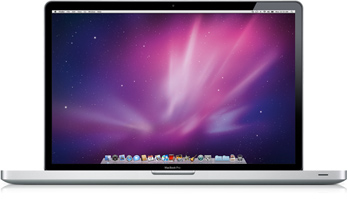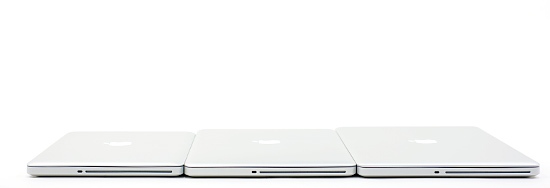Done for 2009: The Holiday MacBook Pro Roundup
by Anand Lal Shimpi on November 10, 2009 12:00 AM EST- Posted in
- Mac
And The Story Begins
Traditionally the notebooks with the largest screens are the least attractive, have the worst battery life and are heavy. They're also usually cheaper than their smaller brethren to give people a reason to buy them.
Take a look at what Dell and HP offer with a 17-inch screensize:
| 17.3-inch Notebooks | Dell Studio 17 | HP Pavillion dv7t Quad Edition |
| CPU | Intel Core i7 720QM (1.6GHz, up to 2.8GHz Turbo) | Intel Core i7 720QM (1.6GHz, up to 2.8GHz Turbo) |
| Memory | 4GB DDR3-1066 | 4GB DDR3-1066 |
| HDD | 250GB 7200RPM | 320GB 7200RPM |
| Video | ATI Mobility Radeon HD 4650 1GB | NVIDIA GeForce GT 230M 1GB |
| Optical Drive | 8X Slot Load DL DVD +/-R | 8X Slot Load DL DVD +/-R |
| Screen Resolution | 1600 x 900 | 1600 x 900 |
| Battery | 9-cell 85Whr | 8-cell ??WHr |
| Dimensions (W x D x H) | 16.28" x 11.04" x 1.1" - 1.54" | 16.2" x 10.9" x 1.37" - 1.70" |
| Weight | 7.08 lbs (6-cell battery) | 7.74 lbs |
| Price | $1099 | $1069.99 |
In both cases you're looking at over 1" thick at the thinnest point, and in the case of the HP system it goes up to 1.7" thick. Both machines start at 7 lbs and don't offer higher than 1080p resolutions. In fact, all the larger screen is useful for is reducing DPI as you can get the same resolution screen in 15-inch and 16" models. The hardware is usually fast and affordable, both machines cost less than $1000.
The 17-inch MacBook Pro is a bit different.

At 0.98" thick, it's only 0.03" thicker than the 13-inch or 15-inch MacBook Pro. And that's a constant thickness from front to back. The impact on how it feels is tremendous. It's the first 17-inch notebook I've used that doesn't make me want to laugh at first sight. It honestly just looks and feels like a slightly bigger 15-inch machine.
| 17.3-inch Notebooks | Apple 17-inch MacBook Pro | HP Pavillion dv7t Quad Edition |
| CPU | Intel Core 2 Duo 2.8GHz | Intel Core i7 720QM (1.6GHz, up to 2.8GHz Turbo) |
| Memory | 4GB DDR3-1066 | 4GB DDR3-1066 |
| HDD | 500GB 5400RPM | 320GB 7200RPM |
| Video | NVIDIA GeForce 9400M (integrated) + NVIDIA GeForce 9600M 512MB (discrete) | NVIDIA GeForce GT 230M 1GB |
| Optical Drive | 8X Slot Load DL DVD +/-R | 8X Slot Load DL DVD +/-R |
| Screen Resolution | 1920 x 1200 | 1600 x 900 |
| Battery | 95Whr | 8-cell ??WHr |
| Dimensions (W x D x H) | 15.47" x 10.51" x 0.98" | 16.2" x 10.9" x 1.37" - 1.70" |
| Weight | 6.6 lbs | 7.74 lbs |
| Price | $2499 | $1069.99 |
It’s also Apple’s most expensive notebook. Starting at $2499, it’s more expensive than the 27” iMac and doesn’t even come with a quad-core processor. You’re paying for the screen size, as you can get the same hardware in the 15” MacBook Pro.
The added size is used for one purpose: a higher screen resolution. Apple offers a single display option with the 17-inch machine: a native 1920 x 1200 panel. It's a 16:10 aspect ratio panel, measuring 17-inch on the diagonal, resulting in a pixel density of 133.2 pixels per inch (PPI).
| 17.3-inch Notebooks | Pixels per Inch |
| Apple 13-inch MacBook Pro | 113.5 |
| Apple 15-inch MacBook Pro | 101.6 |
| Apple 17-inch MacBook Pro | 133.2 |
| Apple 27-inch iMac | 108.8 |
| Apple 30-inch Cinema Display | 101.6 |
| 15-inch 1080p Panel | 141.2 |
That’s more than a 30” display. That's more than the 27" iMac. That's more than any other 17-inch notebook on the market today. Only the 15-inch 1080p panels offer a higher pixel density at 141.2 PPI. It's sharp.
Apple makes the 17-inch MacBook Pro very work-focused, you get a ton of desktop space in a package that's honestly not bulky. I can't stress how pleasant it is to carry around; at a constant thickness of less than 1" it really feels a lot smaller than it is. It's the only 17-inch notebook I'd be willing to take with me.

From left to right: 13-inch, 15-inch, 17-inch MacBook Pro. Note the constant height.
The 17-inch MacBook Pro was the first to use Apple's integrated batteries out of necessity. Apple wanted to build a slim, attractive 17-inch MacBook Pro, and cutting down on battery volume enabled that. A side effect was that the 17-inch model has impressive battery life.
Paired with a 95Whr battery, Apple promised up to 8 hours of battery life - a realistically attainable figure as you'll soon see.
From a hardware perspective the 17” isn’t that much different from the rest of the lineup. The system starts with a NVIDIA GeForce 9400M chipset, adds a separate GeForce 9600M for GPU intensive workloads (3D games, OpenCL apps, etc...) and gives you the option of either a 2.8GHz or 3.06GHz 45nm Core 2 Duo with a 6MB L2 cache. The vast majority of users will find the 9400M is sufficient for their needs. And paired with Snow Leopard, the 9600M in the off state doesn’t sap as much battery power as it did under Leopard.
The machine starts with 4GB of memory, expandable up to 8, and comes with a 500GB 5400RPM SATA drive. SSDs are still only optional from Apple.
The 17” system doesn’t come with an integrated SD card reader but it is the only MacBook Pro to ship with an ExpressCard/34 slot.

From left to right: Power input, Ethernet, FireWire 800, 3 USB, Mini DisplayPort, Line In, Headphone Out, ExpressCard/34
Mini DisplayPort is the only way to connect to an external display, and unfortunately Apple cheeps out and doesn't supply any adapters with the machine. With a 17-inch 1920 x 1200 panel, you'll probably be fine without one though.
About the only thing that the machine is missing is Nehalem, but that won't come until next year.

From left to right: 13-inch, 15-inch and 17-inch MacBook Pro
The 17” MacBook Pro started a new trend within Apple. Integrate the battery, offer longer battery life and no one will complain. The technology soon waterfalled down to the 15” and 13” models.










115 Comments
View All Comments
dagamer34 - Tuesday, November 10, 2009 - link
I doubt the chipset needs to be actively cooled. And plus, TDP is meant to be a "maximum", not an average. Plus, a higher concentration of power, means more heat, which means more cooling is necessary. I don't see Apple adding more fans to facilitate cooling.solipsism - Wednesday, November 11, 2009 - link
If, like in the new iMacs, they move to a 16:9 ratio they may be able to allow for better spreading and a loner vent in the back. Personally, I am not a fan of the 16:9 for reading on a notebook. I’d rather have them finally get rid of the optical drive to make room for more cooling, an extra 5” for ports and even more battery space.dagamer34 - Tuesday, November 10, 2009 - link
Oops, I meant 1600x900 for the 15".SocrPlyr - Tuesday, November 10, 2009 - link
Why doesn't anyone else make a high end laptop like Apple? Hardwarewise, there isn't hardly any (readily available) Windows based PCs that match the specs. As for software, except for a few GUI tricks, Apple still is not capable of writing good software/code. That is clear with pretty much all of their software. They made a good choice for the base of OS X, but as they modify it more and more I can only see things getting worse and worse until we are back at OS 8 levels of garbage (or was it 7 that was so bad). Hopefully they will get things figured out, but I don't have much faith in them.Exelius - Wednesday, November 11, 2009 - link
Um, really? Have you even used a Mac for more than 5 minutes? Snow Leopard is great. I've never used an OS that can remain smooth with uptime numbers like this:10:15 up 29 days, 1:49, 3 users, load averages: 0.66 0.94 0.93
OS X is a terrific, flexible, stable platform. The only drawback is lack of driver support, but even that is changing rapidly.
Please don't post about things which you know nothing about, it only makes you look bad and discounts your arguments. I'm not some rabid Mac zealot (I'm an MCSE and run Windows 7 on several machines at home, so I know Windows very well) but Apple does have a premium product and OS X is a very good OS.
sigmatau - Wednesday, November 11, 2009 - link
Hardwarewise? You mean packaging? You do know their hardware is often a generation or more behind the competition. Not only do you pay a huge premium for the shiny case, you get old hardware to boot. Just look at the processors and video cards available on Macs. Usualy 6months to a year behind the competition.Johnmcl7 - Wednesday, November 11, 2009 - link
Precisely - I don't understand why Apple gets such an easy ride here especially from a tech site. I've had a Dell Studio XPS 16 for a while with a blu-ray drive and RGB LED screen, even budget laptops now come with blu-ray and given Apple's reputation for graphics use they should have had RGB LED displays ahead of anyone else.John
michael2k - Thursday, November 12, 2009 - link
What is your issue? Apple's been shipping LED displays since 2005 on their 15" MBP, and are LED across all laptop systems as of 2008 and all desktops by 2009.Johnmcl7 - Saturday, November 14, 2009 - link
There's a large difference between the two, have a look at the article on this site for the Studio XPS 16 if you're not familiar between the two. Apple currently don't ship any machines with RGB LED backlit displays.Although they do offer LED backlit displays on their machines now, they were also slow to adopt this technology. Given the premium price they charge and this being a tech site I'm surprised they're given so much praise while offering basic or older technology lagging behind rivals. Never mind even rivals, many budget machines are using more advanced technology than Apple do although I guess they need to string out upgrades to ensure people keep buying machines.
michael2k - Saturday, November 14, 2009 - link
So you're asking why Apple doesn't offer cutting edge HW?Apple does; the issue is what HW it is you're looking for. As outlined in the article it is the battery (and battery life) and the physical case design.
Look at the new Adamo and Adamo XPS systems. Dell looks to be charging an arm and a leg, too, for cutting edge physical design.